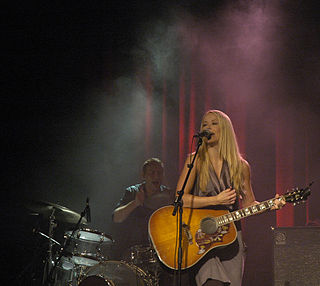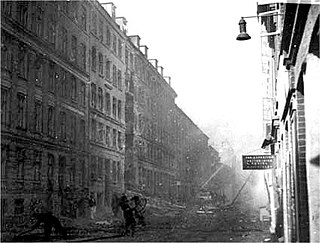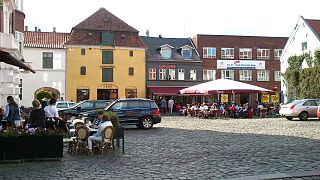
Aarhus is the second-largest city in Denmark and the seat of Aarhus Municipality. It is located on the eastern shore of Jutland in the Kattegat sea and approximately 187 kilometres (116 mi) northwest of Copenhagen.

The Latin Quarter of Paris is an urban university campus in the 5th and the 6th arrondissements of Paris. It is situated on the left bank of the Seine, around the Sorbonne.
Forum or The Forum may refer to:
O2, O-2, o2, or similar orthography may refer to:

The origins of Danish music can be traced back to the Bronze Age. Horns or lurs have been discovered in various parts of Scandinavia, mostly in the region now known as Denmark, since the end of the 18th century. Denmark's most famous classical composer is Carl Nielsen, especially remembered for his six symphonies, while the Royal Danish Ballet specializes in the work of Danish choreographer August Bournonville. Danes have distinguished themselves as jazz musicians, and the Copenhagen Jazz Festival has acquired an international reputation. The modern pop and rock scene has produced a few names of note, including MØ, Dizzy Mizz Lizzy, Lukas Graham, D-A-D, Tina Dico, Aqua, The Raveonettes, Michael Learns to Rock, Volbeat, Alphabeat, Safri Duo, Medina, Oh Land, Kashmir, King Diamond, Outlandish, and Mew. Lars Ulrich is the first Danish musician to be inducted into the Rock and Roll Hall of Fame.
A triangle is a geometric shape with three sides. Triangle may also refer to:

"Where Do You Go To?" is a song by the British singer-songwriter Peter Sarstedt. Its recording was produced by Ray Singer, engineered by John Mackswith at Lansdowne Recording Studios and released in 1969. The music has been described as "a faux European waltz tune", and the arrangement is a very simple one of strummed acoustic guitar and upright bass, with brief bursts of French-style accordion at the start and the end. The arranger and conductor was Ian Green.

"Faubourg" is an ancient French term historically equivalent to "fore-town". The earliest form is forsbourg, derived from Latin forīs, 'out of', and Vulgar Latin burgum, 'town' or 'fortress'. Traditionally, this name was given to an agglomeration forming around a throughway leading outwards from a city gate, and usually took the name of the same thoroughfare within the city. As cities were often located atop hills, their outlying communities were frequently lower down. Many faubourgs were located outside the city walls, and "suburbs" were further away from this location.

The Quartier Latin is an area in the Ville-Marie borough of Montreal, located east of the Quartier des Spectacles and west of the Centre-Sud and Village, centred around UQAM and lower Saint-Denis Street. It is known for its theatres, artistic atmosphere, cafés, and boutiques. It owes its name, a reference to the Quartier Latin in Paris, to the presence of the École Polytechnique de Montréal and the nascent Université de Montréal in the 1920s. In the 1940s the university moved out and headed for a new campus on the north slopes of Mount Royal, far from the downtown borough. In the late 1960s UQAM was born and established itself in the Ville-Marie borough, giving a modern underpinning to the name. A large junior college, the CEGEP du Vieux-Montreal also moved in at about the same period.

Tina Dico is a Danish singer-songwriter. She founded her own record label and releases her music independently, enjoying large success with her albums in her home country as well as critical acclaim across Europe. She is inspired by artists such as Tracy Chapman, Bob Dylan and Leonard Cohen.
A lighthouse is a tower aiding marine navigation.
Montreal was referred to as "Canada's Cultural Capital" by Monocle Magazine. The city is Canada's centre for French-language television productions, radio, theatre, film, multimedia, and print publishing. The Quartier Latin is a neighbourhood crowded with cafés animated by this literary and musical activity. Montreal's many cultural communities have given it a distinct local culture.

Quartier des Spectacles is an arts and entertainment district located in the eastern section of Downtown Montreal, designed as a centre for Montreal's cultural events and festivals.

Operation Carthage, on 21 March 1945, was a British air raid on Copenhagen, Denmark during the Second World War which caused significant collateral damage. The target of the raid was the Shellhus, used as Gestapo headquarters in the city centre. It was used for the storage of dossiers and the torture of Danish citizens during interrogations. The Danish Resistance had long asked the British to conduct a raid against the site. The building was destroyed, 18 prisoners were freed and Nazi anti-resistance activities were disrupted. Part of the raid was mistakenly directed against a nearby school; the raid caused 123 civilian deaths. The incident was dramatised in the 2021 Danish film The Shadow in My Eye. A similar raid against the Gestapo headquarters in Aarhus, on 31 October 1944, had succeeded.

The Latin Quarter in Aarhus is the oldest part of the city and is itself part of the inner city. The quarter comprise the streets of Badstuegade, Klostergade, Volden, Studsgade, Borggade, Rosensgade, Mejlgade and Graven, with Pustervig Torv as the main square.

Else Marie Pade was a Danish composer of electronic music. She was educated as a pianist at the Kongelige Danske Musikkonservatorium in Copenhagen. She studied composition first with Vagn Holmboe, and later with Jan Maegaard, from whom she learned twelve-tone technique. In 1954, she became the first Danish composer of electronic and concrete music. She worked with Pierre Schaeffer and Karlheinz Stockhausen, as well as Pierre Boulez.
Trine Søndergaard, is a Danish photography-based visual artist. Trine Søndergaard lives and works in Copenhagen, Denmark.

Aarhus Pride is a pride parade in Aarhus, Denmark and the largest Danish event focused on LGBT issues outside Copenhagen. The first event was held in 2012 and has been repeated every year since. It is managed and controlled by private individuals from the LGBT community and supported with funds from the city of Aarhus. In 2017, about 6,000 people took part in the 3.5-kilometre-long (2.2 mi) parade with floats and flags.











